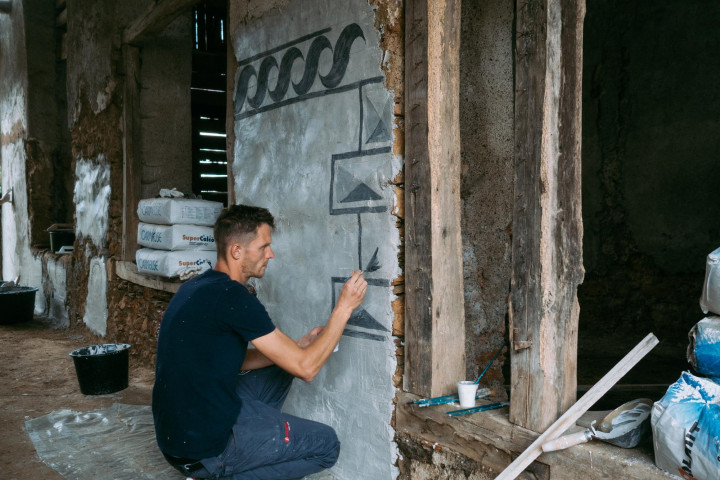The church area in Kameňany became place for international workshop
Between 23rd and 25th of May a workshop with international participation took place in the area of the church and rectory in Kamenany. In the framework of the RE project, with the participation of forty volunteers and four lecturers, we worked on planting and maintenance in the church grounds and in the nearby parish, learning to work with lime plasters using traditional techniques. All alterations to the listed site were consulted and approved by the county conservation office.
Within the church grounds we concentrated on four activities: the professional remedial pruning of two mature small-leaved lime trees situated under the church enclosure wall was carried out by a certified arborist Marek Áč. The pruning was preceded by an inspection of the trees, then the crowns of the trees were cleaned of dry or crossed branches to ensure healthy tree growth in the long term. The "skirt" of young branches around the trunk above ground level will be removed in the near future for the possibility of checking the vitality of the trunk.
Landscape and garden architect Michala Poláková led the landscaping of the site. This involved the planting of a new lime tree in a position that follows the original ring of hawthorn trees and at the same time in such a way that it will not obscure the view of the church from the main axis of the approach to the village, even in the future. The necessary distance from the boundary wall and the church building has also been maintained. The work also included the sowing and topping of a meadow mix of annuals and perennials in a small segment of the site, in areas where the horse chestnut trees had been felled in the past.
An important intervention was the revitalisation of the perennial bed by the World War I memorial. Dry-loving perennial seedlings were used here in a configuration designed by the landscape architect. Emphasis was placed on using plants that may have been present in the area in the past and are appropriate to a monumental or rural setting.
The inhabitants of Kameniany were of course instructed in the care of individual plants and trees, and were themselves largely involved in the planting or other preparatory work. We consider this to be the first right step towards building up the residents' relationship with the monuments in their surroundings.
Outside the church grounds, activities took place to work with traditional lime plasters. The first activity was the preparation of slaked lime using the method of overnight ripening, under the guidance of Viera Kozárová. This is a method she has been using for a long time in the restoration of the Coburgs' manor house in Jelšava.
The presentation of contemporary methods of applying and finishing the surface of plaster from the Gothic, Renaissance, Baroque and 19th century periods was led by the restorer Juraj Gregorek, who has been working on the restoration of the local church for a long time.
The work also included the production of natural pigments such as charcoal black and ceramic or clay ochre. Participants could also try Renaissance painting in the form of illusionary bossage or other techniques of painting on wet plaster, such as simulating the finishing of the surface of freshly applied plaster by punching (used for haloes), making stencils and seals.
The workshop was attended by guests from partner organisations ID20 from Idrija, Slovenia and Herculane Project from Băile Herculane, Romania.





